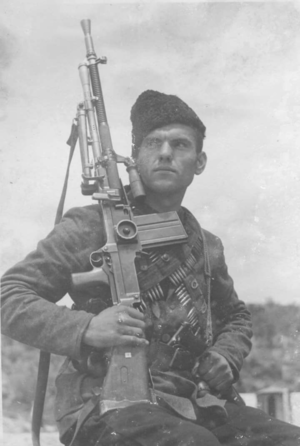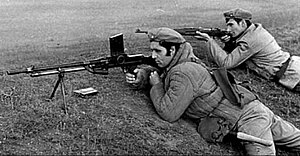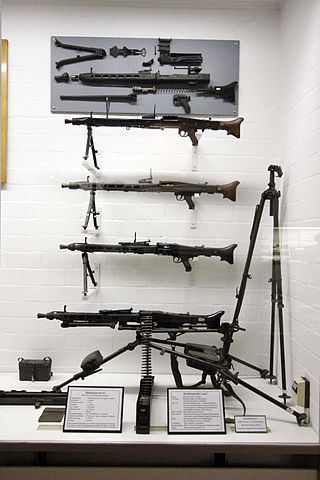
A general-purpose machine gun (GPMG) is an air-cooled, usually belt-fed machine gun that can be adapted flexibly to various tactical roles for light and medium machine guns. A GPMG typically features a quick-change barrel design calibered for various fully powered cartridges such as the 7.62×51mm NATO, 7.62×54mmR, 7.5×54mm French, 7.5×55mm Swiss and 7.92×57mm Mauser, and be configured for mounting to different stabilizing platforms from bipods and tripods to vehicles, aircraft, boats and fortifications, usually as an infantry support weapon or squad automatic weapon.

The Bren gun was a series of light machine guns (LMG) made by Britain in the 1930s and used in various roles until 1992. While best known for its role as the British and Commonwealth forces' primary infantry LMG in World War II, it was also used in the Korean War and saw service throughout the latter half of the 20th century, including the 1982 Falklands War. Although fitted with a bipod, it could also be mounted on a tripod or be vehicle-mounted.

The vz. 52 rifle is a semi-automatic rifle developed shortly after the Second World War in Czechoslovakia. Its full name is 7,62mm samonabíjecí puška vzor 52. Vz. 52 is an abbreviation for vzor 52, meaning "model 52". It fires the unique 7.62×45mm cartridge. 52 rifles were made by Považské strojárne in Považská Bystrica, but due to production difficulties, its manufacture was taken over by Česká zbrojovka Uherský Brod.
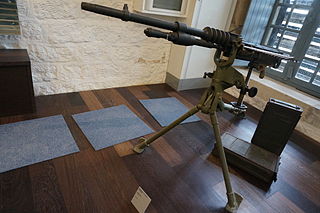
The Mle 1914 Hotchkiss machine gun chambered for the 8mm Lebel cartridge became the standard machine gun of the French Army during the latter half of World War I. It was manufactured by the French arms company Hotchkiss et Cie, which had been established in the 1860s by American industrialist Benjamin B. Hotchkiss. The gas-actuated Hotchkiss system was first formulated in 1893 by Odkolek von Ujezda and improved into its final form by Hotchkiss armament engineers, American Laurence Benét and his French assistant Henri Mercié.
The vz. 24 rifle is a bolt-action carbine designed and produced in Czechoslovakia from 1924 to 1942. It was developed from the German Mauser Gewehr 98 line, and features a similar bolt design. The rifle was designed in Czechoslovakia shortly after World War I, to replace the Vz. 98/22, also a Czech derivative of the Gewehr 98. The vz. 24 featured a 590 mm (23.2 in) barrel which was shorter and considered more manageable than the 740 mm (29.1 in) Gewehr 98 barrel. The vz. 24 was chambered in 7.92×57mm Mauser like its predecessors.

The ZB vz. 26 was a Czechoslovak light machine gun developed in the 1920s, which went on to enter service with several countries. It saw its major use during World War II, and spawned the related ZB vz. 27, vz. 30, and vz. 33. The ZB vz. 26 influenced many other light machine gun designs including the British Bren light machine gun and the Japanese Type 97 heavy tank machine gun. The ZB-26 is famous for its reliability, simple components, quick-change barrel and ease of manufacturing. This light machine gun in the Czechoslovak army was marked as the LK vz. 26. ZB vz. 26 is incorrect nomenclature because "ZB-26" is a factory designation, while "vzor 26" or "vz. 26" is an army designation.
The Type 97 heavy tank machine gun was the standard machine gun used in tanks and armored vehicles of the Imperial Japanese Army during World War II, and as a heavy machine gun by infantry forces. This weapon was not related to the Type 97 aircraft machine gun used in several Japanese Navy aircraft including the Mitsubushi A6M Zero, or the Type 97 automatic cannon used as an anti-tank rifle.

Remington Rolling Block is a family of breech-loading rifles that was produced from the mid-1860s into the early 20th century by E. Remington and Sons.

The Madsen is a light machine gun that Julius A. Rasmussen and Theodor Schouboe designed and proposed for adoption by Colonel Vilhelm Herman Oluf Madsen, the Danish Minister of War, and that the Royal Danish Army adopted in 1902. It was the world's first true light machine gun produced in quantity and Madsen was able to sell it in 12 calibres to over 34 countries. The gun saw extensive combat usage for over 100 years, with continued use in limited quantities worldwide into the 2010s. The Madsen was produced by Compagnie Madsen A/S.

The Besa machine gun was a British version of the Czechoslovak ZB-53 air-cooled, belt-fed machine gun.

Zastava Arms is a Serbian manufacturer of firearms and artillery, based in Kragujevac, Serbia. In 1853, it was founded, and cast its first cannon. It is the leading producer of firearms in Serbia and is a large contributor to the local defense industry. Zastava Arms produces and exports a wide variety of products to over forty countries, including the Zastava M70, a Kalashnikov rifle.

The Hotchkiss M1922 was a light machine gun manufactured by Hotchkiss.

The FN Model 1924 series is a line of Mauser Gewehr 98 pattern bolt-action rifles produced by the Belgian Fabrique Nationale. They are similar to the Czech vz. 24 rifle, however have an intermediate length action, featuring open sights, 7.65×53mm, 7×57mm or 8×57mm IS chambering, Long rifle, Short Rifle and carbine-length barrels, hardwood stocks, and straight or curved bolt handles. This pattern rifle was discontinued from production and was no longer offered after 1932 being totally replaced by the 1930 pattern.

The ZB-53 was a Czechoslovak machine gun. A versatile weapon, it was used both as a squad support weapon, as a mounted machine gun for tanks and other armoured vehicles, and on fixed positions inside Czechoslovak border fortifications. Adopted before World War II by the armies of Czechoslovakia (as Těžký kulomet vz. 37, heavy machine gun model 37) and Romania, it was also license-built in the United Kingdom as the Besa machine gun. Following the German invasion of Czechoslovakia, large quantities of the weapon were captured by the Wehrmacht and used during the war under the designation of MG 37(t).
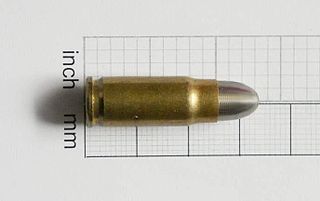
The 7.63×25mm Mauser round is a bottleneck, rimless, centerfire cartridge, originally developed for the Mauser C96 service pistol. This cartridge headspaces on the shoulder of the case. It later served as the basis for the 7.62mm Tokarev cartridge commonly used in Soviet and Eastern Bloc weapons.
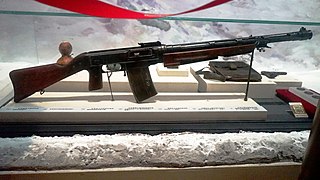
The SIG KE7 is a light machine gun designed and manufactured in Switzerland in the decade before the Second World War. Although exported, it was never used by the Swiss Army.

The Mauser Model 1895 is a bolt operated magazine fed rifle using the 7×57mm Mauser cartridge. It was exported to many overseas powers, including the Chilean forces which adopted as the Fusil Mauser Chileno Modelo 1895. It is the first major modification of the Mauser Model 1893 and was produced by Deutsche Waffen und Munitionsfabriken, known as DWM, and Ludwig Loewe Company from 1895 to 1900.

The Fusil ametrallador Oviedo is a Spanish copy of the ZB vz. 26 and ZB vz. 30 Czechoslovak light machine guns.
The Mauser Model 1904 and Model 1907 were Gewehr 98 pattern bolt-action rifles produced by Mauser and Deutsche Waffen und Munitionsfabriken (DWM). They were designed for export market. Copies were later produced in China and in Spain.
The Standardmodell rifle is a bolt-action rifle designed to chamber the 7.92×57mm Mauser cartridge. The rifle was developed in 1924 but entered full-scale production in 1933. Officially designed for export and German security guards, it was used by the paramilitary Sturmabteilung (SA) and Schutzstaffel (SS). Export variants were used in South America, Ethiopia, China and the Iberian Peninsula. The carbine version of this rifle was almost identical with the Karabiner 98k that became the standard German service rifle during World War II.
